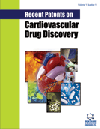-
s Editorial Focus on Cardiovascular Disease, Diabetes and Vessel Fibrosis
- Source: Recent Patents on Cardiovascular Drug Discovery (Discontinued), Volume 7, Issue 1, Apr 2012, p. 1 - 1
-
- 01 Apr 2012
Abstract
The eight individual papers that is our pleasure to highlight in the April, 2012 issue of “Recent Patents on Cardiovascular Drug Discovery” integrate state-of-the-art advances in basic vascular biology with the translational impact of relevant recent patents focusing on improved clinical outcomes. A major challenge for the contributing Authors of this issue was to present the critical underlying pathophysiologic features typical of a spectrum of cardiovascular diseases in a comprehensive, yet critical, forum whereby treatment innovations could be communicated to both the basic and clinical science communities. In this regard, the most recent issue of “Recent Patents on Cardiovascular Drug Discovery” has not only achieved this goal but also provides a dynamic platform for the exchange of ideas and concepts in the context of the next generation of translationallyrelevant scientific advances, many of which are garnered from the current patent portfolio. This was a difficult task but one that the Authors and Editors did well attesting to the unique value of this issue that spans the spectrum from basic to translational to clinical utility. The important contributions to this issue include: 1. The role of the adenosine receptor A3AR as a clinically-relevant cardioprotective target (Nizhat et al). 2. Novel treatment strategies for ischemic stroke focusing on new fibronolytic agents, sonothrombolysis therapy and clot retrieval as therapeutically-useful modalities (Calabro et al). 3. Vaso-protective effects of the incretin system and medications that mimic or increase gucagon-like peptide-1 activity on the treatment of diabetic vascular disease (Motta et al). 4. The impact of peroxisome proliferators-activated receptor-γ modulation as an approach to reduce cardiovascular risk and disease in the context of insulin resistance (Yew et al). 5. Asrpin as a therapy in cardiovascular disease (Ugurlucan et al). 6. A focus on the short- and long-term efficacy of anti-coagulants in the treatment and prevention of venous thrombosis in heart failure patients (Shariff et al). 7. A critical analysis of the pathophysiology of atherosclerosis-associated endothelial dysfunction and recent developments in treatment options to reverse disease progression (Briasoulis et al). 8. The role of stem/progenitor cells and advances in biocompatible materials as novel components and vehicles in the creation of cardiovascular implants with enhanced functional and self-renewal characteristics (Cheema et al). As Co-Editor-in-Chief, a position with which it is my pleasure to share with Dr. Raouf Khalil, I wish to express my particular thanks to Bentham Science for their on-going commitment to the highest quality science, to Sumaiya Azhar, our Publication Manager, and the entire Bentham Editorial Staff that have done an exceptional job in insuring the highest standards of peer review. I would like to particularly acknowledge the untiring contributions of our distinguished cadre of Editorial Board Members who do the lion's share of the reviews and are largely responsible for the exceptional quality of the current and past issues. I also wish to thank all our readers; your comments and submissions significantly contribute to the success of this series. I encourage all of you to contact me directly with your suggestions, criticisms and ideas that will help us all make “Recent Patents on Cardiovascular Drug Discovery” meet the expectations that it is meant to do.


